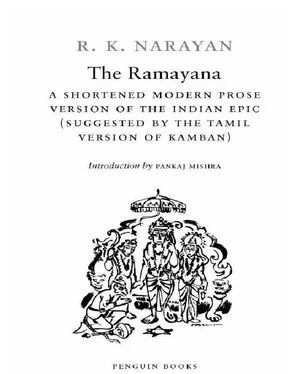Махариши Вальмики - The Ramayana
Здесь есть возможность читать онлайн «Махариши Вальмики - The Ramayana» весь текст электронной книги совершенно бесплатно (целиком полную версию без сокращений). В некоторых случаях можно слушать аудио, скачать через торрент в формате fb2 и присутствует краткое содержание. Жанр: Старинная литература, на английском языке. Описание произведения, (предисловие) а так же отзывы посетителей доступны на портале библиотеки ЛибКат.
- Название:The Ramayana
- Автор:
- Жанр:
- Год:неизвестен
- ISBN:нет данных
- Рейтинг книги:3 / 5. Голосов: 1
-
Избранное:Добавить в избранное
- Отзывы:
-
Ваша оценка:
- 60
- 1
- 2
- 3
- 4
- 5
The Ramayana: краткое содержание, описание и аннотация
Предлагаем к чтению аннотацию, описание, краткое содержание или предисловие (зависит от того, что написал сам автор книги «The Ramayana»). Если вы не нашли необходимую информацию о книге — напишите в комментариях, мы постараемся отыскать её.
The Ramayana — читать онлайн бесплатно полную книгу (весь текст) целиком
Ниже представлен текст книги, разбитый по страницам. Система сохранения места последней прочитанной страницы, позволяет с удобством читать онлайн бесплатно книгу «The Ramayana», без необходимости каждый раз заново искать на чём Вы остановились. Поставьте закладку, и сможете в любой момент перейти на страницу, на которой закончили чтение.
Интервал:
Закладка:
Shortly, Rama’s Vimana arrived. Rama’s mothers, including Kaikeyi, had assembled at Nandigram to receive him. The reunion was a happy one. The first thing that Rama did was to discard his austere garments. He groomed and clothed himself as befitting a King, and he advised Sita to do likewise. Vasishtha received the new King and Queen and fixed the hour for the coronation, interrupted fourteen years before.
Epilogue
Rama entered Ayodhya, after fourteen years of exile, a time during which he rid this world of evil forces that had tormented it for centuries. It was a happy reunion at the capital. The coronation festivities interrupted fourteen years before were resumed. All Rama’s friends and supporters were around him. Hanuman and Sugreeva and all the rest from Kiskinda were there in human form, in order to conform to the physical features of their hosts. Vibishana, Ravana’s successor at Lanka, also was an honoured guest. Rama was surrounded by his mother and stepmothers, even Kaikeyi having shed her harshness by now. The kings of the earth were there and also all the gods in human form. For Bharatha it was a time of supreme satisfaction; his vow to see his brother on the throne was after all being fulfilled. The time of trials and sacrifices had ended for everyone.
At an auspicious hour of a chosen day Rama was crowned as the emperor. He sat on the throne with Sita beside him under the “white umbrella of the state” (as described by Dasaratha), holding in his right hand his Kodanda, the bow which had served him so well all these years. Lakshmana stood one step behind him, devoted and watchful, and Hanuman knelt at his feet, looking up, with his palms pressed in worship, ready to spring into action at the slightest command.
Hanuman, when he was young, as we saw in an earlier chapter, had been advised by his father to dedicate his life in the service of Vishnu. He had followed this advice without a second thought from the moment he realized that Rama was none other than the incarnation of Vishnu. Hanuman is said to be present wherever Rama’s name is even whispered. At a corner of any hall, unnoticed, he would be present whenever the story of Rama is narrated to an assembly. He can never tire of hearing about Rama, his mind having no room for any other object. The traditional narrator, at the beginning of his story-telling, will always pay a tribute to the unseen Hanuman, the god who had compressed within himself so much power, wisdom, and piety. Hanuman emerges in the Ramayana as one of the most important and worshipful characters; there is a belief that to meditate on him is to acquire immeasurable inner strength and freedom from fear.
The story of Rama actually concludes with the enthronement of Rama, but in a traditional narration the story-teller would show great reluctance to reach the end. He will describe in minute detail, as Kamban has done, the arrangements for the coronation, the antecedents of the guests, and the glorious impressions that they carried in their minds when they returned home after enjoying Rama’s hospitality for one full month.
During his narration the story-teller would not miss any chance for a contemporary reference. He would compare the Pushpak Vimana to a modern airliner, with the additional capacities that it could be piloted by mere thought and that its space could expand to accommodate as many as would want to get into it. One may remember that Rama invited an entire army to travel with him when leaving Lanka. On another occasion the narrator would have referred to the “Bala” and “Adi-Bala” mantras as a kind of air-conditioning in those days (p. 11). With such occasional flashes of modernity he would enliven his narration, but in the main he would know all the ten-thousand five hundred stanzas of Kamban by heart and quote them freely in song or verse, and also make his narrative significant with philosophical and religious interpretations now and then. His oral narrative would cover, in the course of forty days, the whole period from Rama’s birth to his coronation, and would be addressed to an audience numbering anywhere from a couple of hundred to thousands, each instalment of narration occupying not less than three hours. On a special occasion, such as the episode of Rama’s marriage, of course, he would slow down and go into details of the wedding, and would be rewarded by his audience with gifts of clothes and money, and he himself would distribute sweets to celebrate the occasion. Again, when Hanuman presented Rama’s ring to Sita at Asoka Vana, the audience, having subscribed among themselves, would present him with a gold ring. And when he brought the story to its pleasant conclusion, the portrait of Rama enthroned would be carried in a procession with lights and music.
I am omitting a sequel which describes a second parting between Rama and Sita, with the latter delivering twins in a forest, and concluding with Rama and Sita leaving this world and returning to their original home in the heavens. But this part of the story is not popular, nor is it considered to be authentic, but a latter-day addition to Valmiki’s version. Kamban does not take note of this sequel but concludes his tale on the happy note of Rama’s return to Ayodhya, followed by a long reign of peace and happiness on this earth. And there I prefer to end my own narration.
R. K. NARAYAN
Glossary
areca —a variety of palm
ashram —hermitage
asthra —weapon, missile or arrow powered by supernatural forces
asura —a demon
Brahma Rishi —an enlightened sage
dharba —a stiff grass generally collected for ritual purposes
durbar —court
Gandharva —a supernatural being
mantra —syllables with magic potency
margosa —a shade tree whose leaves are bitter
Maya —illusion
musth —a secretion on the forehead of an elephant during mating season
Pushya —a star
rakshasa —a demon
sadhu —a recluse or saint
sanyasi —an ascetic
shastra —scriptures
simsupa —a tree
vanji —a rare flowering creeper, which blooms once in twelve years
veena —a stringed musical instrument
yagna —a sacrifice
yaksha —a demigod
yojana —a measure of distance, usually of about 5 miles
1
The story of its composition is told in “Valmiki” in the author’s Gods, Demons, and Others.
2
I have given an idea of an original Tamil epic in Gods, Demons, and Others, in the chapter entitled “The Mispaired Anklet.”
3
See “Viswamitra” in Gods, Demons, and Others.
4
Lust, anger, miserliness, egoism, envy.
5
See “Manmata” in Gods, Demons, and Others.
6
Manmatha, the god of love.
7
Another name for Sita.
8
A subtle compliment to Sita’s figure; a slender waist being an aesthetic point stressed often and in various ways by classical poets.
9
Ravana was known as an accomplished veena player.
10
“Each yuga lasts for 3000 years, by celestial measurements; but one celestial year is the equivalent of 3600 years of human time, so that the four yugas cover a span of 43,200,000 mortal years. Each of the four yugas . . . possesses special characteristics of good and evil. . . . In Kaliyuga righteousness, virtue, and goodness completely disappear. Rites and sacrifices are abandoned as mere superstitions. Anger, distress, hunger, and fear prevail, and rulers behave like highwaymen, seizing power and riches in various ways.” Gods, Demons, and Others.
Читать дальшеИнтервал:
Закладка:
Похожие книги на «The Ramayana»
Представляем Вашему вниманию похожие книги на «The Ramayana» списком для выбора. Мы отобрали схожую по названию и смыслу литературу в надежде предоставить читателям больше вариантов отыскать новые, интересные, ещё непрочитанные произведения.
Обсуждение, отзывы о книге «The Ramayana» и просто собственные мнения читателей. Оставьте ваши комментарии, напишите, что Вы думаете о произведении, его смысле или главных героях. Укажите что конкретно понравилось, а что нет, и почему Вы так считаете.












